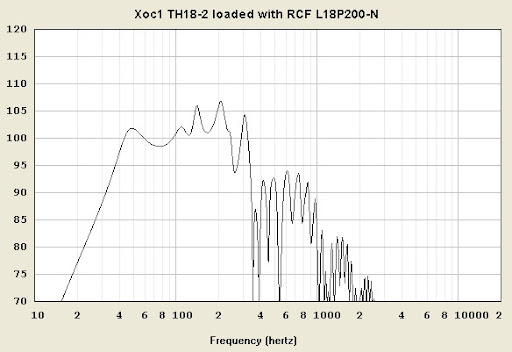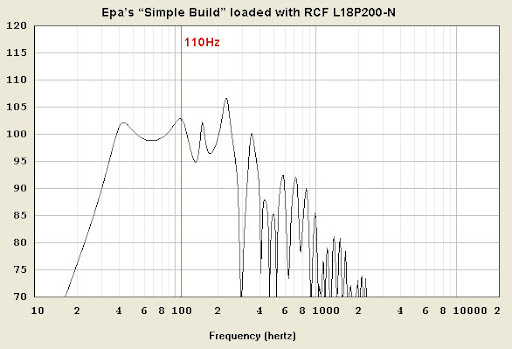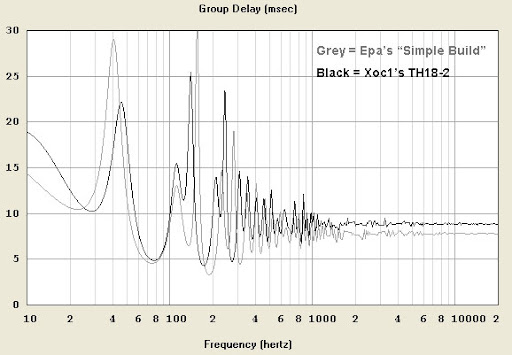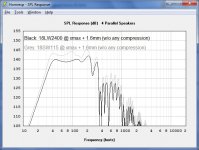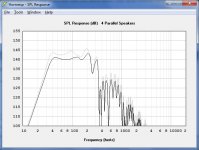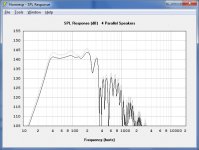Originally Posted by Xoc1
If you have a 18" driver in mind for a replacement then you could make an adaptor plate. If you use 18mm timber the dip at 120hz might be a bit deeper.
Originally Posted by m R g S r
Opposed to what thickness of timber? I thought 18mm was recommended.
I was referring to using 18mm for the adaptor plate
Added to the 18mm baffle would give 36mm of depth to the baffle.
I added this to the sim by using Vtc and Atc and reduced S4 by 80 cm sq
The effect noticed was the dip at 120hz was bigger and the gain at 40Hz was minimaly less. The dip at 120 is far more effected by the driver inductance.
I suppose the ideal would be to cut a 18mm thk ring to reduce the existing baffle hole to suit the 15 driver and use a doubling plate made out of material like 3mm steel - but it would be up to the builder to decide if it was worth the additional effort & expense.
Sim on this? Non-neo RCF driver, decent xmax. Slightly low on the power handling...
RCF L18P200-N 18" Woofer Speaker
RCF L18P200-N 18" Woofer Speaker
this one is al worked out for the rcf L18p-200-n.Sim on this? Non-neo RCF driver, decent xmax. Slightly low on the power handling...
RCF L18P200-N 18" Woofer Speaker
one sheet 5'x10' plus one piece for speaker mounting .
real simple bild too.
neo dan have bild simular boxes ,and is gona bild more
Hmm doesn't look like much of an advantage compared to the complicated TH18 construction.
I just posted that driver as another possible option.
I hope I'm happy with the 18 sound drivers! I can try them with thd 1300 rms or so and with the xti bridged into a single cabinet for around 2000rms. If I like they output that much better with it bridged I'll buy another xti 4000 to power the second cabinet.
I just posted that driver as another possible option.
I hope I'm happy with the 18 sound drivers! I can try them with thd 1300 rms or so and with the xti bridged into a single cabinet for around 2000rms. If I like they output that much better with it bridged I'll buy another xti 4000 to power the second cabinet.
Epa's cab will do better under 40Hz! However the big disadvantages are; worse group delay and very limited bandpass compared to the Xoc1 cab. In sound the difference is more obvious as the big gap in response from Epa's cab will influence the sound in a bad way (Jbell already found that out in his big TH constructions similar to Epa's design, also the THAM suffers from the same gap in response).
So the difference isn't big in graphs but will be in reality...
(Martin we need a thread for your design, the info stream is already messing up this thread! )
)
So the difference isn't big in graphs but will be in reality...
(Martin we need a thread for your design, the info stream is already messing up this thread!
Last edited:
At just 800 watt (AES pwr rating RCF L18P200-N) your 18Sound already has 2dB (>1,8dB to be exact based on my info) more output. At 1600 watt your 18Sound has already >3dB more output and at this power you will smell the RCFI hope I'm happy with the 18 sound drivers!
The Radio Shack meter reads down below 30 Hz, but you do need to add a few dB down low as it uses a "C" weighting.m R g S r: do you have an SPL meter?
What SPL meters are available that are perhaps better bang for buck (or just more accurate/read down to 30Hz without breaking the bank) than the Radio Shack (Rat Shack) meter?
When the "C" weighting is compensated for, my Radio Shack analog meter reads very close to flat in the LF range.
Before getting Smaart, I was using an Audio Toolbox, a fairly high priced (around $1500 "B" stock) dB meter/RTA/etc. and thought for a while all my sub projects were turning out to have poor LF response, when I found the microphone was 8 dB down at 30 Hz when set for "flat". The RS meter is only about 3 dB down at 30 Hz.
Although I have found the RS meters to be consistent in response, others report variations. The RS meters are pretty bullet proof though, I have owned several through the years, some lasting over a decade of road use.
Pretty much any cheap meter is going to have some variations due to microphone differences, the RS is probably as good as any that you don't spend big money on. You will want to read at two meters or more to prevent overload on most of the cheap dB meters.
Most of the design simulations in this thread seems to roll off at 40 Hz, what happened to "flat to 30"
Ah yes - SMAART! How accurate might you think my older version of SMAART with the dbx RTA-M may be? I'll be using my ECHO AudiFire4 firewire interface.
The 30Hz cabs are in the beginning of this thread They ended up being quite large, so we made a compromise and went with 35Hz. A quite nice compromise it turned out to be
They ended up being quite large, so we made a compromise and went with 35Hz. A quite nice compromise it turned out to be 
The 30Hz cabs are in the beginning of this thread
The DBX mic is actualy quiet good for LF measuring. It is flat within 1/2dB between 55Hz and 800Hz. Below 55Hz is starts to drop nicely till about -2,4dB at 20Hz. As far as I have seen from different production lines they were all alike which is a good sign for quality production lines. But with measuring mics it also important how you store them. Your Echo firewire-card's AD converter is also good enough for reliable measurements.Ah yes - SMAART! How accurate might you think my older version of SMAART with the dbx RTA-M may be? I'll be using my ECHO AudiFire4 firewire interface.
Last edited:
Here's a quick comparison of the 18Sound 18LW2400 and the B&C 18SW115 ($120 more from Parts Express).
B&C 18SW115:
AES = 1700
Xmax = 14 mm
BL = 30.3 Tm
Mms = 275 g
I don't have compression numbers for this driver, but maybe Djim and others can chime in on this drivers expected performance
B&C 18SW115:
AES = 1700
Xmax = 14 mm
BL = 30.3 Tm
Mms = 275 g
I don't have compression numbers for this driver, but maybe Djim and others can chime in on this drivers expected performance
I wish it was that simple Crescendo... Just compare the motor/moving mass ratio against the excursion and HornResp doesn't show the costs in THD and pwr compression...
BMS 18N850 V2:
AES = 1200 W
Xmax = 12 mm
BL = 25,4 Tm
Mms = 240 gram
18Sound 18LW2400:
AES = 1200 W
Xmax = 9,5 mm
BL = 25,6 Tm
Mms = 192 gram
RCF LF18N451:
AES = 1500 W
Xmax = 8,8 mm
BL = 30,2 Tm
Mms = 235 gram
You can see the extreme Xmax of the BMS that looks very tempting. But you also you can see it uses a similar motor compared to the 18Sound to move a cone that is even more heavy then the RCF cone! I'll bet that will result in more pwr compression...
So to me that means 80$ more for the BMS and plenty more to amplify the extra losses to get it at Xmax (if it doesn't burn before you get there...). Again, I repeat my statement that people look way to much to the Xmax and forget about the rest...
Attachments
The DBX mic is actualy quiet good for LF measuring. It is flat within 1/2dB between 55Hz and 800Hz. Below 55Hz is starts to drop nicely till about -2,4dB at 20Hz. As far as I have seen from different production lines they were all alike which is a good sign for quality production lines. But with measuring mics it also important how you store them. Your Echo firewire-card's AD converter is also good enough for reliable measurements.
Ok, great! I have stored my mic in the foam lined molded plastic case it came in, in a cool place. Thought that'd be OK.
(4) 18LW2400 vs 18SW115 & LF18N451 @ MME
Before I get flame from Djim here are comparisons of the 18LW2400 up against the 18SW115 and LF18N451 @ MME (Max Efficient Excursion (BL50%)). I found this formula:
here are comparisons of the 18LW2400 up against the 18SW115 and LF18N451 @ MME (Max Efficient Excursion (BL50%)). I found this formula:
BL x 0,017) + 0,9 = BLc
BLc x Xmax = Max Efficient Excursion (BL50%)
Or:
[(BL x 0,017) + 0,9] x Xmax = Max Efficient Excursion (BL50%)
posted by Djim several pages back and was unaware of it's existence. If it has been revised, please share
The thing to keep in mind with these two HR plots (besides compression) is that the 18SW115 is at its AES limit while the 18Sound and RCF plots are well under theirs.
Grey lines are 18SW115. 18LW2400 is plot on the left; LF18N451 on the right.
What are your thoughts?
Before I get flame from Djim
BL x 0,017) + 0,9 = BLc
BLc x Xmax = Max Efficient Excursion (BL50%)
Or:
[(BL x 0,017) + 0,9] x Xmax = Max Efficient Excursion (BL50%)
posted by Djim several pages back and was unaware of it's existence. If it has been revised, please share
The thing to keep in mind with these two HR plots (besides compression) is that the 18SW115 is at its AES limit while the 18Sound and RCF plots are well under theirs.
Grey lines are 18SW115. 18LW2400 is plot on the left; LF18N451 on the right.
What are your thoughts?
Attachments
Lol............, the reason I was looking for such formula was because my earlier attempts with "Xlim -7dB for continue power" and "Xlim -4dB for max power", were accused of too much simplification and unrealistic. However, these formulas are still standing as a rock in my view. The other formula you are referring to you can forget. That was nothing more than an attempt to get around the other way which lead to a dead end actually.Before I get flame from Djim............. [(BL x 0,017) + 0,9] x Xmax = Max Efficient Excursion (BL50%) ..........
What are your thoughts?
In a world without power compression a balanced PA driver means it will reach its Xmax at its AES continues power in an optimised basreflex cab. At 2 x AES power it will reach its 50% BL. At 4 x its AES power it will reach Xlim (this point is also referred to as: AES continue power + 6dB or so called Crest factor).
So these formulas were only to prove my point for using AES power ratings for TH's just the same way you would use them for basreflex cabs (as long the Fb is above the Fs of the driver of course).
That means for your B&C it's 14mm Xmax should be theoretically reached at 1700 watts.
Last edited:
- Home
- Loudspeakers
- Subwoofers
- C/E/X PA Flat to 30 (FT30) PA TH Awesomeness
